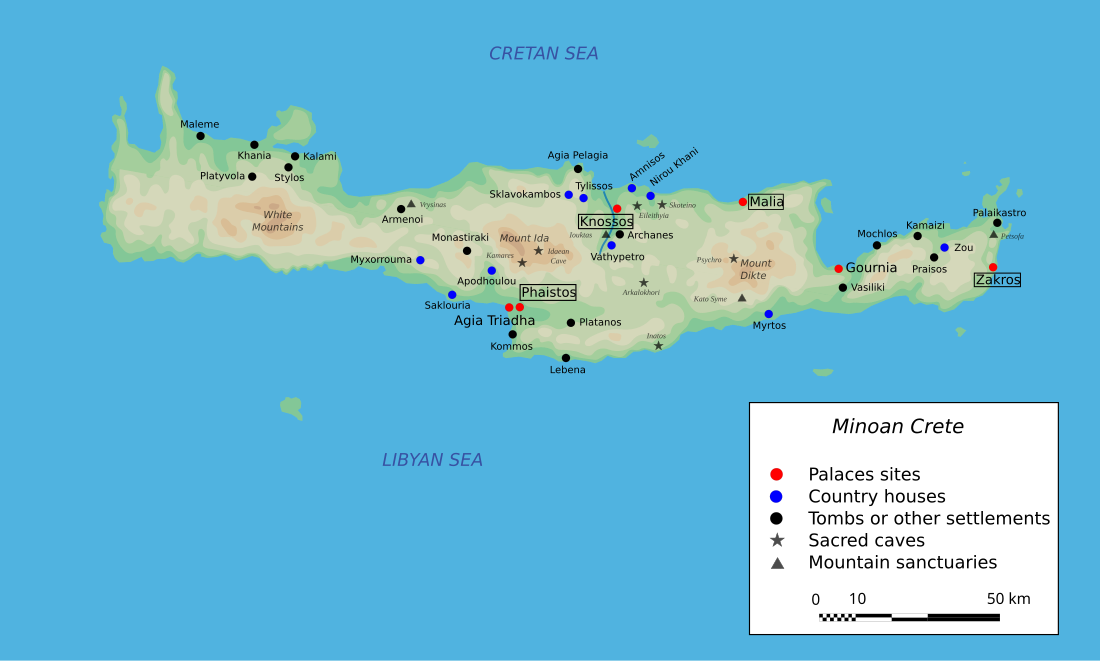Top Qs
Timeline
Chat
Perspective
Galatas Palace
Archaeological site in Greece From Wikipedia, the free encyclopedia
Remove ads
The Galatas Palace is a Minoan archaeological site in Heraklion, Crete, Greece about 30 kilometers southeast of the city of Heraklion discovered in the early 1990s. Built on a older Protopalatial settlement dating to the MM IB (c. 1925–1875 BC) period, a Minoan palace was constructed in the early Neopalatial Period, during the Early MM IIIA period (c. 1750 BC). The palatial center was destroyed by a conflagration at the end of the MM IIIA period.[1]

The east wing is the best-preserved part of the structure, while the West and South wings were found to be extensively damaged. Excavations have not been completed in the area of the North wing of the building. The archaeological site is considered to be unique because it is the only such Minoan center to have been built and inhabited during one period.[2]
Remove ads
Archaeology
Summarize
Perspective
The site has been covered by two archaeological surveys. The first in the 1980s led by Nikos Panagiotakis, covered a very wide area (about 800 square kilometers) using an interview based system common at that time.[3] The second between 2005 and 2007, led by L. Vance Watrous, was more narrowly focused (79 square kilometers) and used a field walking approach.[4]
Galatas was discovered in 1992 when illegal excavations revealed the existence of several buildings associated with the Minoans. The site, located at Galatas Kephala, some 30 km south of Heraklion, and near the modern village of Galatas, was excavated under the guidance of archaeologist Dr. George Rethemiotakis.[5] By 1997, he announced that a new Minoan palace had been discovered.[6][7]
Excavation of the 4000 square meter palace has unearthed a large, paved central courtyard oriented north and south, that measured 16 meters by 32 meters. This is a typical feature of other Crete palatial sites (i. e., Knossos, Phaistos, Malia, and Zakros).[8] They found remnants of a four-wing building that once surrounded the central court, also reminiscent of other Minoan palatial sites. Another unique feature of this Minoan center was a huge hearth measuring 3 meters by 1.5 meters, the first discovered on Crete. Two other hearths intended for feasting were also discovered, along with numerous Minoan ceramic finds, indicating large feasting events.[9]
Work has also occurred on the settlement area associated with the palace. In 2007 a single-room shrine with goddess figure was found in Building 6, a large mansion southwest of the palace. The building had two occupation layers dated MM IIIA and LM 1A-B and included a Lustral basin.[10] Remains of the earlier Protopalatial settlement, destroyed in the area of the Neopalatial palace, cover a sizable area outside of that palace.[11]
Remove ads
History
The site was occupied beginning in the Early Minoan I (EM I) (c. 3100–2650 BC) period based on pottery traces. In the Protopalatial MM IB (c. 1925–1875 BC) period a settlement arose in the northern area. At the beginning of the Neopalatial Early MM IIIA period (c. 1750 BC) a palace was constructed after leveling the MM IB buildings in that area. The Protopalatial remains were used as fill. By the end of the Late Minoan IB the palace had been abandoned and then destroyed by conflagration though occupation continued in the associated settlement. This occupation continued until the LM III A2-B period.[12][11]
Remove ads
See also
References
Further reading
Wikiwand - on
Seamless Wikipedia browsing. On steroids.
Remove ads

